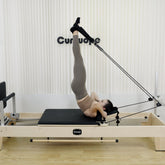Is it better to use a Pilates Reformer with or without shoes?What are some common Pilates Reformer mistakes to avoid?
When it comes to using a Pilates Reformer, there are certain things to consider in order to optimize your workout and avoid common mistakes. Two of the most common questions that people have are whether they should use shoes or not and what are some common mistakes to avoid.

Is it better to use a Pilates Reformer with or without shoes?
One of the great things about using a Pilates Reformer is that it is versatile and can be used with or without shoes. There are benefits and drawbacks to each option, and the decision ultimately comes down to personal preference.
Using shoes during a Pilates Reformer workout can provide additional stability and support for the feet and ankles. This can be especially helpful for people who have weak or unstable ankles or feet. Additionally, using shoes can protect the feet from the hard surface of the Reformer and prevent blisters or other foot injuries.
On the other hand, some people prefer to do Pilates Reformer workouts barefoot, as it allows for better connection to the equipment and can improve balance and proprioception (awareness of one's body in space). It can also promote better foot mobility and flexibility.
If you are using a shared Pilates Reformer, it may be more hygienic to wear shoes to protect your feet from any bacteria or germs on the machine.
Ultimately, the decision to wear shoes or go barefoot during a Pilates Reformer workout is up to personal preference and individual needs.
What are some common Pilates Reformer mistakes to avoid?
Focusing too much on the equipment: While the Pilates Reformer can be a great tool for building strength and flexibility, it is important to remember that it is just one part of the Pilates method. It is important to focus on the movement and alignment of the body rather than solely on the equipment.
Not engaging the core: The core muscles are a key part of the Pilates method and are essential for stabilizing the spine and improving overall posture. It is important to engage the core muscles throughout the entire Pilates Reformer workout.
Using improper form: Using improper form during Pilates Reformer exercises can lead to injury or strain on the muscles and joints. It is important to focus on proper alignment, movement, and breathing techniques.
Overworking certain muscles: Pilates Reformer exercises should be balanced and work all areas of the body evenly. It is important to avoid overworking certain muscles or neglecting others.
Pushing too hard: It is important to listen to your body and avoid pushing too hard during a Pilates Reformer workout. Overexertion can lead to injury or muscle strain.
Improper alignment: Pilates Reformer exercises require precise alignment to avoid strain or injury. Make sure to maintain proper form throughout each exercise, keeping your shoulders down and back, your core engaged, and your spine in a neutral position.
Holding your breath: Breathing is a key component of Pilates Reformer exercises. It is important to inhale deeply through your nose and exhale fully through your mouth during each movement to help engage your core and promote relaxation.
Rushing through exercises: Pilates Reformer exercises are designed to be slow and controlled. Avoid rushing through movements or using momentum to complete an exercise. Instead, focus on using your muscles to perform each movement with control and precision.
By being mindful of these common Pilates Reformer mistakes and avoiding them, you can optimize your Pilates Reformer workout and achieve better results.





